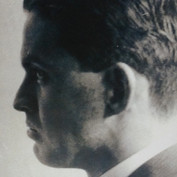
Biography
Itapetininga, Brazil, 1895 —
Ubatuba, Brazil, 1967
The importance of Antonio Gomide’s performance in the first modernist generation has become a chapter in the history of Brazilian art since Walter Zanini pointed out “the impossible omitted from the history of our modernism”.
Gomide was born in the interior of São Paulo and as a young man he moved with his family to Switzerland, where he attended the Geneva Academy of Fine Arts until 1918. From the 1920s, the artist began to live in France. In 1922, in Toulouse, he worked in the studio of Marcel Lenoir and later, between 1924 and 1926, he lived in Paris. The works of this period are influenced by cubism and art deco, characterized by the schematization of figures from circular and pointed shapes and by the predominant work with the line both in the delimitation of images and in the creation of the pictorial movement of true vertices of attention. , notable in the works Casal Abraçado (1922), Mulher e menina (1922) and A Samaritana (1925). Together with the production of stained glass and decorative elements, the pictorial works produced by Gomide during his stay in France are mostly dedicated to living models, everyday scenes, landscapes and religious motifs. In this context, the painting Os caçadores (1928) stands out as an announcement, in the theme and in the color palette, of the painter’s return to his homeland: shining amid the intense green of the closed forest, the look of each character leads the observer towards the invisible target of the arrows.
Arriving in Brazil only in 1929, therefore without having participated in the Modern Art Week of 1922, Antonio Gomide was well received by the modernist circle and supported the foundation of important spaces such as the Sociedade Paulista Pró-Arte Moderna and the Clube de Artistas Modernos, in 1932. In addition, working together with brother-in-law John Graz and sister Regina Gomide Graz, the artist became one of the main introducers of art deco in Brazil, both through residential projects and through public works, such as the rich stained glass set that makes up the entrance portal of Parque da Água Branca, in São Paulo, a work developed in partnership with Casa Conrado and inaugurated in 1935.
From 1940 on, Antônio Gomide carried out works focused on the national scene, its physical environment and its social and cultural aspects. From then on, the human form appears in more natural, fluid and at the same time more corpulent, volumetric and sensual figures. This renewed desire for volume and spatiality is also present in Gomide’s sculptural works, carried out after the artist lost his sight. However, it is especially in the painting of dance scenes as in the works Bailarinas (1946), Dança (1949), Roda de samba (1956) and Bailarina (1958) that the artist rethinks the body element, building energetic, violent, carnal and of a sonority that catches the arrow of the gaze and makes it rotate and oscillate, rendered by the rhythm of the balance between color and line.
GGS

